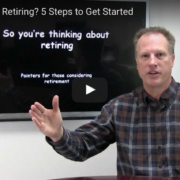Are the Markets Singing a Familiar Tune?
Just over 50 years ago on January 11, 1973, while Carly Simon was on the radio singing her new number-one hit “You’re So Vain,” the S&P 500 closed at a then all-time high of $120.20. Unbeknownst to the U.S., many things were about to change.
The following 21 months saw a decline in the S&P of almost 48%, the biggest drop since the 1930s. Within a short time, the Vietnam War ended. The Watergate trial started. Roe v. Wade was decided in the Supreme Court. Lyndon Johnson died. A whole generation of investors who had experienced one of the most powerful expansions in the American economy, multiplying the value of the markets some eight-fold, experienced the “unimaginable.”
Yet the market didn’t stay at its low. It did what it has a history of doing: temporarily cutting in half, only to eventually continue its advance.
For those experiencing the drop, it felt like the wheels were falling off the wagon. Dark clouds hovered over the economy, global stability, and domestic politics. The common yet consistently incorrect theme of “this time is different” rang through the media and among investors. Many acted on the philosophy of moving money to cash, only to see its purchasing power vanish to rampant inflation: every investor’s greatest risk.
Today feels very similar to the early 1970s for many reasons, including our challenges with inflation, energy, recession, and political strife. Let’s explore what was happening back then, so we can compare it to what’s happening today.
It’s easy to forget that the global monetary protocol supporting our past 50-year boom was the U.S. dollar, which in the early 1970s was backed by gold priced at about $35 an ounce. President Nixon essentially was forced to abandon the gold standard in August of 1971. In his attempt to beat the inflation found in the wake of that decision, he instituted wage and price controls that only made the problem worse. In 1972, the annual inflation rate, measured by the Consumer Price Index (CPI), was 3.27%. His efforts caused the CPI to move up to 6.16% in 1973, then 11.03% in 1974. Politics and unnecessary regulation only exasperated inflation.
In October of 1973, as Israel was observing Yom Kippur, a collation of Arab states led by Egypt and Syria launched a surprise attack on Israel. When America countered with military support, Saudi Arabia embargoed oil sales to the U.S., ultimately leading to the 1973 energy crisis. Oil prices rose four-fold until the embargo was lifted in 1974. Energy prices, more than any other factor, drove inflation to its high levels. This repeated in 1979 with problems in Iran.
Back in the U.S., political scandal thrived. Watergate revealed that one political party had been effectively spying on another, creating a constitutional crisis not seen since the Civil War. Vice President Agnew was forced to resign for taking bribes, and the President attempted to fire the special prosecutor investigating his party in the Watergate matter. The attorney general and his successor both resigned rather than fire Special Prosecutor Archibald Cox. Our democracy appeared to be in shambles, all while Nixon tried to imply his innocence, only to resign in August of 1974.
With inflation causing the prices of goods and services to increase 10%, primarily driven by energy prices, the U.S. walked into a 16-month long recession. Unemployment rose to 9%, and the economy contracted 3.2%, the deepest recession in 15 years.
Does any of this sound familiar? History doesn’t often repeat, but it does rhyme. The difference between then and now is our perspective and ability to see the outcome of past challenges as a country. Despite everything, the real GDP of the United States went from $26,000 per person in 1972 to almost $60,000 per person today, roughly a 2.3-fold increase. We innovated, created, and ushered in an unprecedented era of growth and productivity. America took several years to regain its position as the world’s largest producer of oil, but we did it. We muddled through until we triumphed. That is what America does.
It wasn’t just the GDP either. Compare the end of 1972 to the end of 2022:
- In 1972, corporate earnings of the S&P 500 were at $6.17. The 2022 consensus appears to be close to $220 (a 36-fold increase).
- In 1972, dividend of the S&P 500 was $3.19. The 2022 consensus will be in the $65 per share area (a more than 20-fold increase).
- In 1972, the S&P was at 120. Today it is at 4,000 (a 33-fold increase).
- The CPI rose from a price level of $42.60 to $296.80 (a seven-fold increase).
So amid economic peril, political collapse and turmoil, international instability, and countless other anxieties, America’s businesses grew by multiples.
The key to success in investing, as Peter Lynch described it, is to, “Not get scared out of them.” The long-term S&P annual compound rate of total return from the top of the market in 1973 to the end of 2022 was +10.2%. Had an investor parked $10,000 and left it to compound (dividends reinvested, taxes paid from another source) untouched over the years, it would have grown to $1,250,000 — even after accounting for all the deep and shallow economic downturns and bear markets we’ve seen over the years.
I can’t imagine this time will be any different.
Steve Booren is the Owner and Founder of Prosperion Financial Advisors, located in Greenwood Village, Colo. He is the author of Blind Spots: The Mental Mistakes Investors Make and Intelligent Investing: Your Guide to a Growing Retirement Income and a regular columnist in The Denver Post. He was recently named a Barron’s Top Financial Advisor and recognized as a Forbes Top Wealth Advisor in Colorado.









